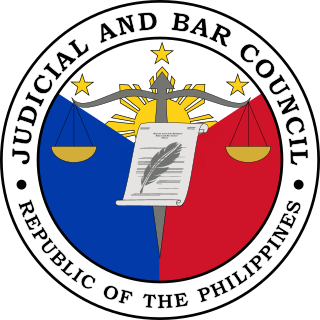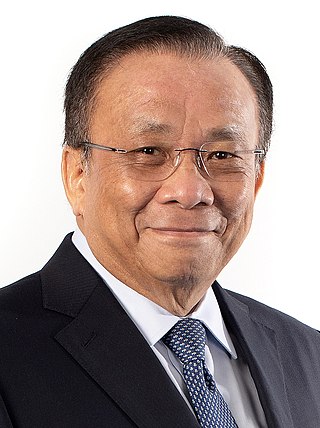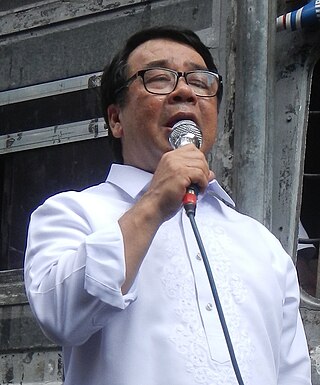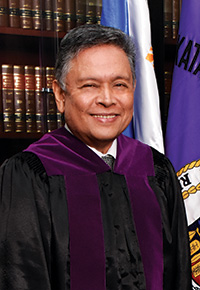
The Supreme Court (Filipino: Kataas-taasang Hukuman; colloquially referred to as the Korte Suprema, is the highest court in the Philippines. The Supreme Court was established by the Second Philippine Commission on June 11, 1901 through the enactment of its Act No. 136, an Act which abolished the Real Audiencia de Manila, the predecessor of the Supreme Court.
Executive Order No. 464 is a controversial executive order issued in the Philippines on September 26, 2005, by President Gloria Macapagal Arroyo that prevents cabinet members, police and military generals, senior national security officials, and "such other officers as may be determined by the President" to attend congressional hearings unless the President gives permission to those who will attend the said proceedings.
Impeachment in the Philippines is an expressed power of the Congress of the Philippines to formally charge a serving government official with an impeachable offense. After being impeached by the House of Representatives, the official is then tried in the Senate. If convicted, the official is either removed from office or censured.

The Judicial and Bar Council of the Philippines is a constitutionally-created body that recommends appointees for vacancies that may arise in the composition of the Supreme Court, other lower courts, and the Legal Education Board, and in the offices of the Ombudsman, Deputy Ombudsman and the Special Prosecutor.

The Sandiganbayan is a special appellate collegial court in the Philippines that has jurisdiction over criminal and civil cases involving graft and corrupt practices and other offenses committed by public officers and employees, including those in government-owned and controlled corporations. The special court was established by Presidential Decree No. 1486. It was subsequently modified by Presidential Decree No. 1606 and by Republic Acts 7975, 8249 and 10660. It is equal in rank to the Court of Appeals, and consists of fourteen Associate Justices and one Presiding Justice. The Office of the Ombudsman owns exclusive authority to bring cases to the Sandiganbayan.

Renato Tereso Antonio Coronado Corona was a Filipino judge who was the 23rd chief justice of the Philippines from 2010 to 2012. He served as an associate justice after being appointed by President Gloria Macapagal Arroyo on April 9, 2002, and later as Chief Justice on May 12, 2010, upon the retirement of Chief Justice Reynato Puno.

Presbitero Jose Velasco Jr. is the incumbent Governor of Marinduque and was a former Associate Justice of the Supreme Court of the Philippines. He was appointed to the Supreme Court by President Gloria Macapagal Arroyo on March 31, 2006.

Cancio Castillo Garcia was a Filipino lawyer and jurist who served as an Associate Justice of the Supreme Court of the Philippines. He was appointed to the Court on October 6, 2004, by President Gloria Macapagal Arroyo and retired on October 19, 2007.
Maria Alicia Austria-Martinez is a Filipino jurist who served as an associate justice of the Supreme Court of the Philippines from 2002 to 2009. She was appointed to the Court by President Gloria Macapagal Arroyo on April 12, 2002.
Continuing legal education is required of members of the Integrated Bar of the Philippines (IBP) to ensure that throughout their career, they keep abreast with law and jurisprudence, maintain the ethics of the profession and enhance the standards of the practice of law.
Legal education in the Philippines is developed and offered by Philippine law schools, supervised by the Legal Education Board. Previously, the Commission on Higher Education supervises the legal education in the Philippines but was replaced by the Legal Education Board since 1993 after the enactment of Republic Act No. 7662 or the Legal Education Reform Act of 1993.

Arturo Dizon Brion is a former associate justice of the Supreme Court of the Philippines. He took his oath as a member of the Supreme Court on March 17, 2008. From 2006 until his appointment to the Supreme Court, Brion served in the cabinet of President Macapagal-Arroyo as the Secretary of the Department of Labor and Employment.
Alfredo Logronio Benipayo is the former Dean of the University of Santo Tomas Faculty of Civil Law, the oldest law school in the Philippines. He is a former magistrate and a respected law professor and bar reviewer in the country.
Gregory Santos Ong is a Filipino jurist and a former Justice of the Sandiganbayan. He was initially appointed as an Associate Justice of the Supreme Court of the Philippines by President Gloria Macapagal Arroyo on May 16, 2007, but his appointment was subsequently withdrawn after questions arose whether he met the constitutional requirement of natural-born citizenship. On September 23, 2014, he was found guilty of gross misconduct, dishonesty and impropriety and was subsequently dismissed from his position as Justice of the Sandiganbayan by the Supreme Court of the Philippines as a result of an investigation linking him to pork barrel scam mastermind Janet Lim-Napoles.
Ruben T. Reyes was a Filipino jurist who served as an Associate Justice of the Supreme Court of the Philippines from 2007 to 2009.

Lucas “Luke” Purugganan Bersamin is a Filipino lawyer and jurist who currently serves as the 40th Executive Secretary of the Philippines. Bersamin previously served in the Supreme Court of the Philippines for 10 years, first as an associate justice from 2009 to 2018 and then as the 25th Chief Justice of the Philippines from 2018 until his retirement in 2019. He was named by President Gloria Macapagal Arroyo to the high court as an associate justice on April 2, 2009. Prior to becoming an associate justice, he was a member of the Court of Appeals.

Neri Javier Colmenares is a Filipino legislator, human rights lawyer and activist. He was an associate of the Asian Law Centre at Melbourne Law School when he was completing his Ph.D. in law on "The Writ of Amparo and the International Criminal Court." He also lectured at the University of Melbourne on International Human Rights Law and the Rome Statute of the International Criminal Court.

Eugene Alvarez Tan (1943–1994) was a Filipino human rights lawyer, author, and professor of law. He was murdered in 1994.
Martin S. Villarama Jr. is a Filipino lawyer who served as an associate justice of the Supreme Court of the Philippines from November 3, 2009, to January 16, 2016. Prior to his appointment as Associate Justice of the Supreme Court, he served as Associate Justice of the Court of Appeals since March 11, 1998. He also served in the Regional Trial Court of Pasig as Judge from 1986 to 1998 and as its Executive Judge from 1992 to 1996.

Noel Gimenez Tijam is a Filipino lawyer who served as an associate justice of the Supreme Court of the Philippines from March 8, 2017 to January 5, 2019. Prior to his appointment, he was a justice of Court of Appeals from 2003 to 2017.













